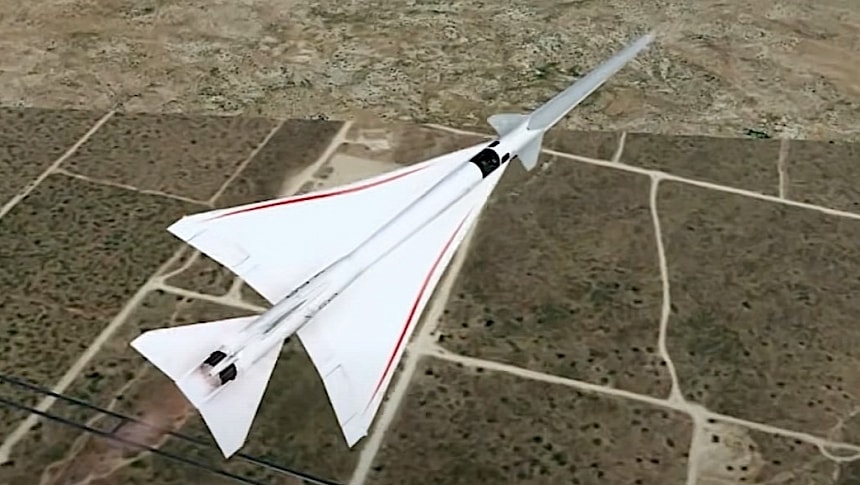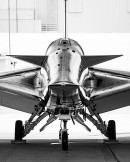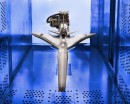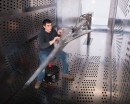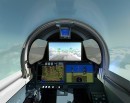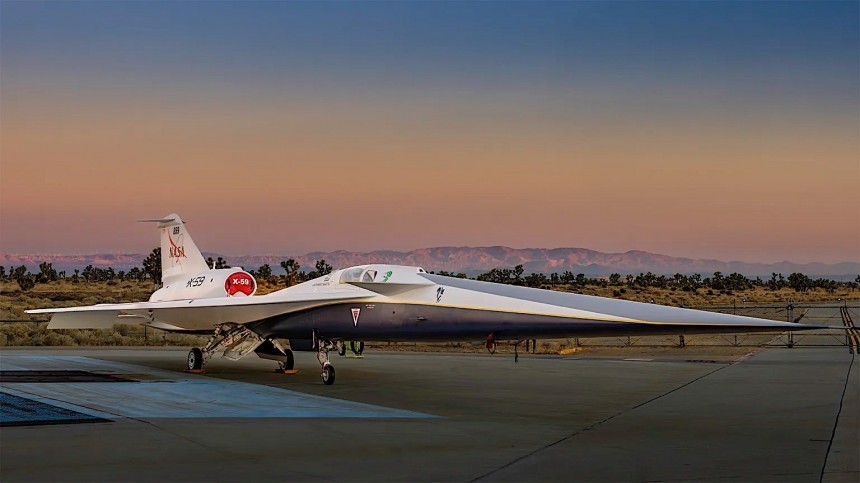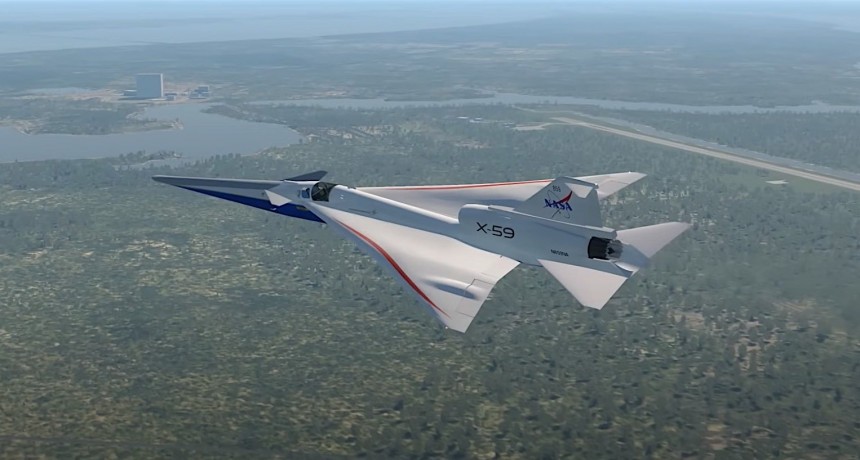Before proving that commercial supersonic flight over land is possible without breaking the law, NASA's experimental supersonic aircraft, the X-59, has to travel the long path of bureaucracy. But unlike the sometimes useless bureaucracy we're faced with almost every day, this one has a clear purpose in mind: ensuring that the upcoming test flights are safe.
For almost a decade now the American space agency has been working on something called the Quiet Supersonic Technology (QueSST). The program is aimed at finding ways to make possible passenger supersonic travel over land, something that's not currently allowed by law because, well, supersonic travel is very, very noisy.
QueSST's goal is to develop an aircraft design that could reduce the loud boom that occurs when traveling supersonic to a thump. With help from aerospace company Lockheed Martin, NASA managed to turn the program into a real-life aircraft called X-59.
In a normal supersonic aircraft the pressure waves created during flight get squashed together as the plane pushes through them, leading to the boom we often hear. How loud is it? Well, consider that an F-16 traveling at an altitude of over 26,200 feet (8,000 meters) generates 78 dB. The only civilian supersonic aircraft to ever fly, the Concorde, was even louder, at 100 dB.
By comparison, the X-59 should get that down to just 60 dB, which is, more or less, the sound you get when closing the door of your car. And the thing should be able to do this thanks to some clever design ideas, including the removal of the front window (the pilot will see outside thanks to cameras and screens that form a suite called the eXternal Vision System), the very long nose gifted with two small wings, and the delta wings.
Shown for the first time to the public in finished form at the beginning of the year, the X-59 is powered by a GE Aviation jet engine that delivers 22,000 pounds of thrust and should be more than enough to push the X-59 to top speeds of Mach 1.4 (925 mph/1,488 kph). The highest altitude it will be capable of reaching is 55,000 feet (15,240 meters).
Despite looking brand new, the plane is a sort of Frankenstein's monster, as it uses parts cannibalized from elsewhere and made to fit and work together. For instance, the canopy pulled over the cockpit comes from a T-38 Talon, the control stick was taken off an F-117, the landing gear once belonged to an F-16, and there's even an undisclosed U2 part installed in the propulsion system.
All these combined parts are expected to fly together for the first time by the end of this year, but before they actually get to do that, the plane that carries them has to clear all the boards that will be assembled to review its design and mission.
The first group of overseers, the ones meant to give the plane its Flight Readiness Review, had already convened, marking the plane entrance on the long paper path that should eventually lead to its flight.
The board, comprising independent experts, looked at the potential hazards the plane could pose, and, given how this is not a make-it-or-break affair, will come up with insights and recommendations for the X-59 team.
The Flight Readiness Review is the first step in clearing the plane for flight, and it will be followed by the Airworthiness and Flight Safety Review. Another group of people, from both NASA and Lockheed Martin, will look at how the findings and recommendations of the first board were implemented, and if everything checks out, it'll clear the NASA Armstrong Flight Research Center's director to give the plane its airworthiness certificate.
In parallel with what happens in board rooms, the X-59 team is hard at work getting the plane ready for the ground tests, which will look at systems integration, engine runs, and electromagnetic interference.
If the plane manages to go through all of the above with no issues, and if it proves it's safe to fly, it will be taken on test runs over populated areas in the U.S. That'll probably happen in 2025, and will be the true test of the design.
Separate teams are already hard at work setting up a system of microphones that will be placed on the ground to record the flight overhead. The data gained this way will be compared to what everyday Americans will have to say about the hypersonic X-59 passing in the sky, and the results will be used to inform the Federal Aviation Administration (FAA).
As far as we know, NASA plans to fly the plane for up to nine months and an undisclosed number of flights. The plane itself is not meant to be the predecessor of some civilian aircraft, but it is only meant to validate some new design ideas and new technologies the aviation players might use for their future flying machines.
QueSST's goal is to develop an aircraft design that could reduce the loud boom that occurs when traveling supersonic to a thump. With help from aerospace company Lockheed Martin, NASA managed to turn the program into a real-life aircraft called X-59.
In a normal supersonic aircraft the pressure waves created during flight get squashed together as the plane pushes through them, leading to the boom we often hear. How loud is it? Well, consider that an F-16 traveling at an altitude of over 26,200 feet (8,000 meters) generates 78 dB. The only civilian supersonic aircraft to ever fly, the Concorde, was even louder, at 100 dB.
By comparison, the X-59 should get that down to just 60 dB, which is, more or less, the sound you get when closing the door of your car. And the thing should be able to do this thanks to some clever design ideas, including the removal of the front window (the pilot will see outside thanks to cameras and screens that form a suite called the eXternal Vision System), the very long nose gifted with two small wings, and the delta wings.
Shown for the first time to the public in finished form at the beginning of the year, the X-59 is powered by a GE Aviation jet engine that delivers 22,000 pounds of thrust and should be more than enough to push the X-59 to top speeds of Mach 1.4 (925 mph/1,488 kph). The highest altitude it will be capable of reaching is 55,000 feet (15,240 meters).
All these combined parts are expected to fly together for the first time by the end of this year, but before they actually get to do that, the plane that carries them has to clear all the boards that will be assembled to review its design and mission.
The first group of overseers, the ones meant to give the plane its Flight Readiness Review, had already convened, marking the plane entrance on the long paper path that should eventually lead to its flight.
The board, comprising independent experts, looked at the potential hazards the plane could pose, and, given how this is not a make-it-or-break affair, will come up with insights and recommendations for the X-59 team.
The Flight Readiness Review is the first step in clearing the plane for flight, and it will be followed by the Airworthiness and Flight Safety Review. Another group of people, from both NASA and Lockheed Martin, will look at how the findings and recommendations of the first board were implemented, and if everything checks out, it'll clear the NASA Armstrong Flight Research Center's director to give the plane its airworthiness certificate.
In parallel with what happens in board rooms, the X-59 team is hard at work getting the plane ready for the ground tests, which will look at systems integration, engine runs, and electromagnetic interference.
Separate teams are already hard at work setting up a system of microphones that will be placed on the ground to record the flight overhead. The data gained this way will be compared to what everyday Americans will have to say about the hypersonic X-59 passing in the sky, and the results will be used to inform the Federal Aviation Administration (FAA).
As far as we know, NASA plans to fly the plane for up to nine months and an undisclosed number of flights. The plane itself is not meant to be the predecessor of some civilian aircraft, but it is only meant to validate some new design ideas and new technologies the aviation players might use for their future flying machines.
